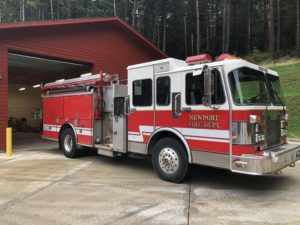
By QUINTON SMITH/YachatsNews
YACHATS – Voter-approved tax levies in 2022 and 2023 are making the job of the Yachats Rural Fire Protection District’s budget committee much easier.
After five years of needing loans to make ends meet between infusions of property taxes, the fire district’s budget committee learned Monday that the district should have a healthy cash carryover of $465,000 when the fiscal year ends June 30.
That carryover could grow to $597,000 by the end of the 2024-25 fiscal year, according to the budget prepared by district administrators Frankie Petrick and Shelby Knife and approved unanimously Monday by the budget committee.
After years of financial struggles, the district is in much better financial shape after voters last November renewed a five-year tax levy of 61 cents per $1,000 assessed property value after also approving a new, much larger levy of $1.59 in 2022.
The district’s five-member board still needs to formally approve the budget at its June 10 meeting. The budget committee consists of the five board members and five appointed citizens, three of whom were absent from Monday’s meeting.
Including the cash carryover of $465,000, the 2024-25 general fund budget is $2.3 million, up from the current $2.08 million.
Knife told the committee that the district should continue to build its cash carryover for another year before rising expenses begins eating into savings. In her budget message, Petrick said the district will have to ask voters to increase the $1.59 levy in 2027 and the 61 cent levy in 2028 when they come up for renewal.
2024-25 budget highlights include:
- Overall, wages for six firefighter/medics and 2.5 administrators and office staff are expected to increase 13 percent to $775,000. Total personnel costs including insurance, retirement, employment taxes and such are predicted to rise by $155,500 to $1.25 million;
- Allocating up to a 5 percent cost of living increase in December for wages, depending on a board decision. Wages could also be increased by 1-5 percent in the spring after individual performance evaulations;
- Allocating $50,000 for needed repairs to its small station/garage on Cornoa Court on the south edge of Waldport and to the station in the Yachats River valley;
- Keeps the contribution from South Lincoln Ambulance at $18,000 for another year in return for the fire district staffing it. In the budget message, Petrick and Knife, who are two of the nonprofit’s board members, said SLA “does not anticipate having extra funds this year due to the need to repair/replace the ambulance.” The ambulance was heavily damaged in a Jan. 11 fatal accident as it left the station’s driveway and pulled onto U.S. Highway 101. South Lincoln Ambulance has been using a replacement provided by Pacific West Ambulance;
The board also has to decide what to do with its onetime “first out” engine it bought for $8,000 from the Newport Fire Department in 2021. The 30-year-old engine failed a pump test and the cost to repair it is estimated at $15,000.

“We need to re-evaluate whether that is the best plan or not,” Petrick said in her budget message, later noting the engine can carry just 500 gallons of water rather than the preferred 1,000 gallons favored by rural departments.
The budget for equipment repair or purchase is increasing from $15,000 this year to $50,000 for 2024-25. One engine out of service also means there is no equipment at the Coronoa Court station, which the district needs to maintain for homeowner insurance purposes.
The district has just $42,500 in its equipment reserve fund, which prompted newly appointed board member Doug Myers to ask if the district needs to be more aggressive to put money aside for future equipment purchases or hiring additional personnel in the future.
“You may need money for extra staffing at some point,” said Myers, who has 46 years experience as a professional firefighter and volunteer.
But Knife said the administration’s current philosophy is to build its new cash carryover to create more flexibility for future needs whether it be equipment, staffing or dealing with increasing costs two, three and four years from now.



